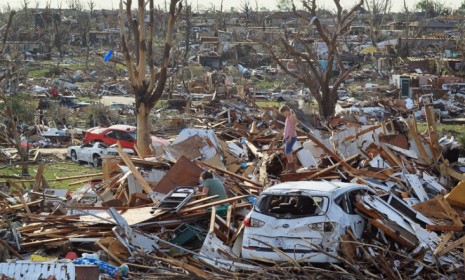Why so many killer tornadoes?
After a brutal one-two punch of twisters, the debate over a possible link between climate change and deadly weather begins anew

Rescuers are still searching for survivors in Joplin, Mo., where at least 116 people were killed by the deadliest tornado to hit the U.S. since 1953. The massive twister — which was up to three-quarters of a mile wide — struck just weeks after several tornadoes struck six southern states, killing at least 314 people, most of them in Alabama. That was the worst death toll from multiple storms since 1925. Weather experts were at a loss to explain the deadly flurry of tornadoes, and the National Oceanic and Atmospheric Administration said it had found no link between the recent storms and climate change. Environmentalists disagree. Is global warming to blame?
Of course climate change is fueling killer weather: "These tornadoes are not originating from Oz," says Gregg Easterbrook at Reuters. The onslaught isn't some "unexpected bolt out of the blue" — it's an entirely predictable result of climate change. And "despite what the talk radio and Tea Party types say, there is strong scientific consensus that human activity has begun to alter Earth’s climate." We deny the evidence at our peril.
"What's causing the tornado tsunami"
The Week
Escape your echo chamber. Get the facts behind the news, plus analysis from multiple perspectives.

Sign up for The Week's Free Newsletters
From our morning news briefing to a weekly Good News Newsletter, get the best of The Week delivered directly to your inbox.
From our morning news briefing to a weekly Good News Newsletter, get the best of The Week delivered directly to your inbox.
Wait, who's ignoring the scientists now? "Oh, for crying out loud," says John Hayward at Human Events. Green liberals complain that those who question their conclusions about climate change ignore science. Yet here they are insisting that every weather expert now saying climate change isn't causing tornadoes is "a complete idiot or a deluded fanatic." It's natural to want to explain a horrible disaster, but don't use that as an excuse to jump "on the 'global warming causes tornadoes' bandwagon."
We simply don't know the truth: There is no question that the number of tornadoes recorded in the U.S. has been rising for decades, says Alok Jha at Britain's Guardian. There is also no question that much of the increase is due to improvements in how we track weather. Plus, there are more people living in "tornado alley" these days, so the potential for storms to be spotted — and to do damage — has multiplied. Is climate change playing a role, too? "The answer is that no one really knows."
"Are tornadoes more common because of climate change?"
A free daily email with the biggest news stories of the day – and the best features from TheWeek.com
-
 Wilde Cambridge: home-away-from-home in a prime city spot
Wilde Cambridge: home-away-from-home in a prime city spotThe Week Recommends This laid-back aparthotel is the perfect base for a weekend of exploring
-
 The best alcohol-free alternatives for Dry January
The best alcohol-free alternatives for Dry JanuaryThe Week Recommends Whether emerging from a boozy Christmas, or seeking a change in 2026, here are some of the best non-alcoholic beers, wines and spirits to enjoy
-
 A lemon-shaped exoplanet is squeezing what we know about planet formation
A lemon-shaped exoplanet is squeezing what we know about planet formationUnder the radar It may be made from a former star